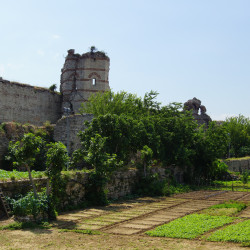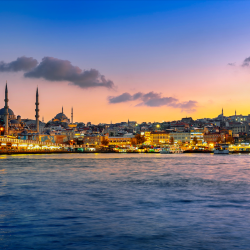Walls of Constantinople
One of the most important issues that any nation faced in the past was protection. Because nations or rather, empires, didn't have access to the kind of technologies that we do today, their solution was simple: Walls. Walls were erected around many a city to defend against sieges. Istanbul or Constantinople as it was once known was no exception. In fact, the Walls of Constantinople were so impressive that they could not be breached for hundreds of years. Today the Walls of Constantinople are one of the most visited, important landmarks of the city, as they denote the complicated and often blood history of the city itself.
A Long History That Spirals the City
But first things first: When were the Walls of Constantinople built? The thing is, this question isn't as simple to answer as it might seem. For there have been many versions, additions and extensions of and to the Walls of Constantinople. The oldest, original version of the walls were built by the first Greek settlers around the Acropolis. And so, began the Walls of Constantinople's history. These walls were only about 6 kilometers long and the section of the wall that faced the land was only about a kilometer long. The wall had 27 towers in all, where catapults were placed, a paltry amount compared to how many towers it ended up with, years later. Once the Romans conquered the region, Emperor Septimius Severus rebuilt the city and the new walls were placed 300 meters west of the original. After the year 324, Constantine the Great decided to expand the city to the west. This meant that the city walls needed to be extended as well. This brings up an important question: How were the Walls of Constantinople built? In other words, who did all the work? The answer is simple yet brutal: Constantine the Great tasked 40.000 prisoners of war, whom he'd captured during the wars against the Goths, with building the wall.
Besieged But Still Standing
The Walls of Constantinople were built primarily for protection. In the year 410, once the emperor found out that Rome had been captured by the Visigoths, yet another wall was added in front of the old ones as a precaution. This fourth wall had 96 towers. The Walls of Constantinople were 12 kilometers long at the time and 12 meters high. The walls were partly destroyed in 447 by a brutal earthquake, which was worrying given the rampage the Huns were on at the time. The emperor immediately had a second wall built in front of the damaged first wall. While he was at it, he had the number of towers doubled and by the time he was done, the walls had a total of 192 towers. This wall came to be known as the Theodosian Wall.
Important Tips and Tours
Today only about 5 and a half kilometers of the Theodosian Wall is left standing. But then where are the Walls of Constantinople exactly? The parts of the walls that have withstood the test of time begin on the shores of the Golden Horn, near the Blachernae Palace, continue on to the Golden Gate and the Sea of Marmara. The current length of the Walls of Constantinople is 22 kilometers. There are eleven gates in total bedecking the walls. If you want to visit the Walls of Constantinople, the best spots to see it from would be the Chora Church, the Palace of Constantine Porphyrogenites, the Edirne Gate and the Gate of the Seven Towers. Lucky for you, you can now take walk on the Istanbul City Walls! This way you can discover the ghost of the city as used to be in the past and immerse yourself in its history. All you have to do is go to istanbul.com and book the Walk on the City Walls Tour, where you will have the chance to visit the Yedikule Fortress where diplomats were imprisoned in the Ottoman Empire!
Who Breached the Unreachable Walls?
The Walls of Constantinople have withstood many a siege and attack. They were so formidable that no medieval force could ever bring them down. The Walls of Constantinople were finally breached by the Ottoman Sultan, Fatih the Conqueror in 1453. After building massive cannons for the sole purpose of bringing down the Walls of Constantinople, he laid siege to the city and on May 29th, 1453 he destroyed the Gate of Saint Romanus with artillery fire. Having breached a hole in the gate, his forces were now free to take the city. And take it they did. Ottoman forces quickly flooded into the city and thus the Byzantine Empire came to an end.
Frequently Asked Question
Do you need tickets to enter the wall portion, and where are the entrances?
There are numerous entrances; I went to one close by after leaving the Chora church.
What is the closing time?
They are free.
What is the overall length of the Byzantine-era historical walls?
26 kilometers
 Spanish
Spanish  Indonesian
Indonesian  Urdu
Urdu  Taiwanese
Taiwanese  Russian
Russian  Romanian
Romanian  Portuguese
Portuguese  Persian
Persian  Macedonian
Macedonian  Korean
Korean  Japanese
Japanese  Italian
Italian  Indian
Indian  Hungarian
Hungarian  Greek
Greek  German
German  Croatian
Croatian  Chinese
Chinese  Bulgarian
Bulgarian  Arabic
Arabic  French
French  English
English 



